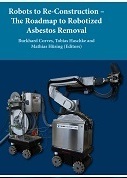Robots to Re-Construction — The Roadmap to Robotized Asbestos Removal
Edited by Burkhard Corves, RWTH Aachen, Germany | Tobias Haschke, RWTH Aachen, Germany | Mathias Hüsing, RWTH Aachen, Germany
Publication Date: 17 Mar 2021
Suggested Citation: Burkhard Corves (ed.), Tobias Haschke (ed.), Mathias Hüsing (ed.) (2021), "Robots to Re-Construction — The Roadmap to Robotized Asbestos Removal", Boston-Delft: now publishers, http://dx.doi.org/10.1561/9781680837155
Downloaded: 25512 times
Description
Europe has paid a high price for asbestos, with over 100 000 related deaths. First in line in the fight to free buildings from asbestos contamination, workers in the construction sector could soon find a helping hand in the form of an AI-piloted robotic system.
The constant and multifaceted evolution of society has left very few industries unchanged. For most sectors, this has meant moving towards increased automation. Most, but not all. One unyielding sector has largely stayed true to its old ways: the construction sector. For the past 200 years, the same repetitive, standardised and physically challenging construction tasks have been performed by workers with their own two hands. But this could change soon, as emerging voices — some of which decided to stand together under the Bots2ReC (Robots to Re-Construction) project — have been calling for the sector to embrace automation. The reasoning behind Bots2ReC is simple: some tasks are simply too hazardous for humans to perform, and machines could easily replace them. Besides the exposure, some processes or the materials handled in those processes generate health hazards in the form of dust, vibration, noise or toxic substances. It is precisely for these tasks that we could expect great benefits from — and also show the massive potential of — automation to achieve sustainable socio-ecological improvements.
With its focus on asbestos, the EU H2020 Bots2ReC project is focusing on reducing the future health burden on workers. There is little doubt that the cost of the technology will easily be counterbalanced by its high social benefit and economic efficiency. This books presents the findings and results of the Bots2ReC project, and should be useful for Construction and Robotics Engineers, as well as graduate level students and researchers active in these fields.
-
ISBN: 978-1-68083-714-8
400 pp. Price: $130.00 Buy Book (hb) -
ISBN: 978-1-68083-715-5
400 pp. Open Access (.pdf) This is published under the terms of CC BY-NC
